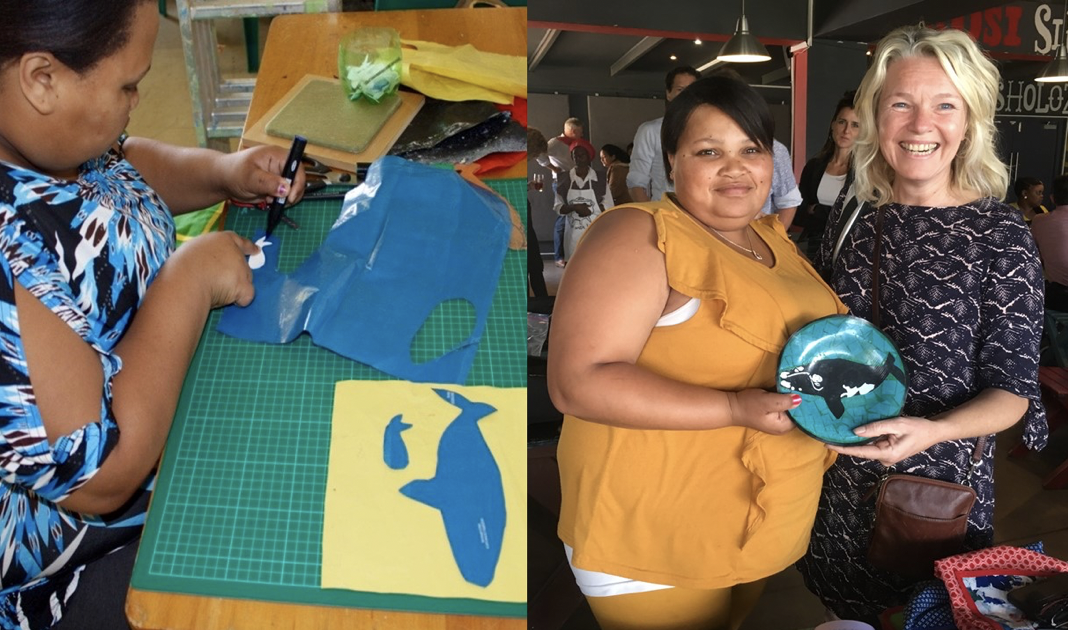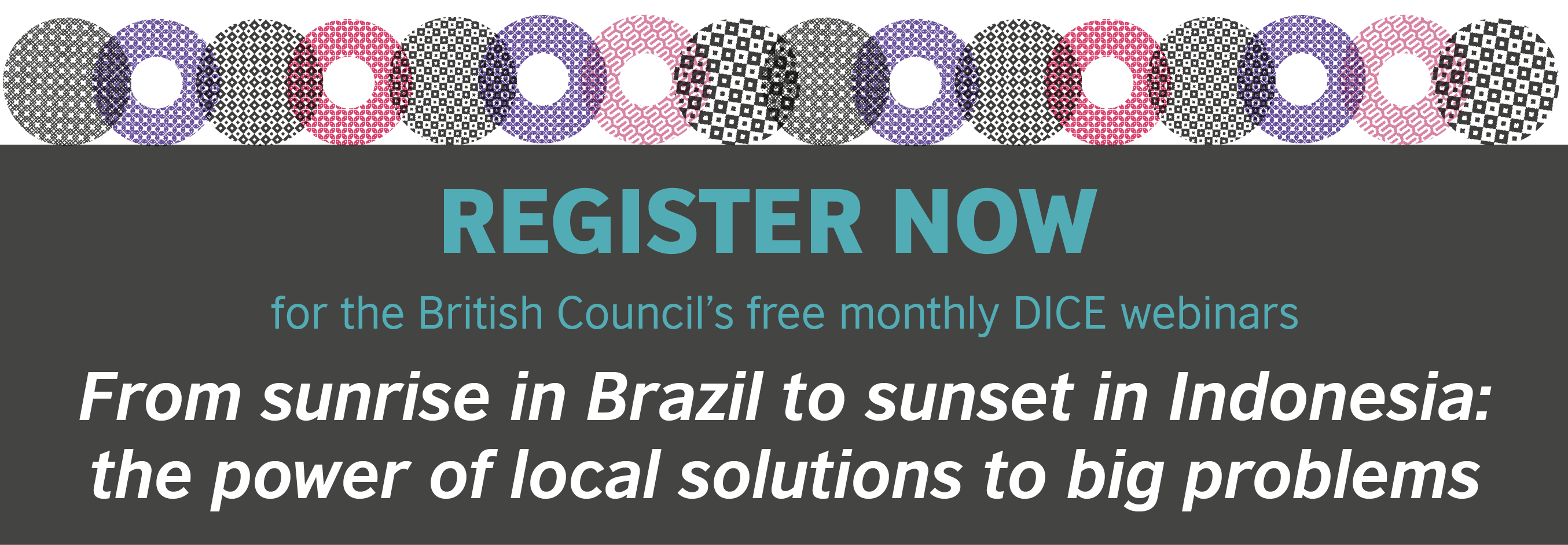Tackling the legacy of inequality and pollution for sustainable futures in South Africa
Residents of a blighted South African township are turning some of the waste that has harmed their environment into a source of income, as well as inviting tourists into their community. Skills are being shared from a team of upcycling experts at the UK's University of Brighton.

The South African community of Melkhoutfontein has suffered some hard knocks over the years. It is located east of Cape Town on the tourist “Garden Route” and only a few kilometres away from the beautiful beaches of the affluent Stillbai seaside resort.
But the community hasn’t been able to benefit much from this location. Some residents are known to be descendants of the KhoeKhoen people who lived on the coast with other indigenous tribes. They are described as “forgotten people”, a first nation in the southwest Cape whose descendants have lived in the area for generations. Yet in 1963 the entire non-white community in the Stillbai and coastal area was forcibly moved out under the apartheid system. They were relocated to Melkhoutfontein, which became a community blighted by harsh socio-economic conditions and recurrent poverty.
In the post-apartheid era, the town has still struggled. Unemployment has been as high as between 50% and 60% with women and school leavers particularly affected. Commercial fishing dried up in the mid-1980s. To make matters worse, for many years the township was sandwiched between two waste dumps, with residents exposed to the polluted air as tons of refuse from the coastal resorts was burnt. The sense of environmental degradation was enhanced by the relentless spread of acacia cyclops, a plant imported from Australia almost a century ago. The plant, known as rooikrans in Afrikaans, has helped stabilise coastal sand dunes – good for tourism – but has had otherwise invasive and harmful effects, destroying indigenous species.
There has been an attempt, over more than two decades, to turn things around. Anthea Rossouw set up the Dreamcatcher Foundation to try and help create sustainable livelihoods for local communities. She explains that her approach was to work with local people to identify negative factors and to try and convert them, somehow, into something positive.
Tourists buy crafts. Where do the crafts come from? They are predominantly made in China
One negative was the waste. It was the source of harm to the environment and to health, but it could also be thought of in a different way, as a free resource. Then there was tourism. How could the community benefit around the periphery of that industry?
“We looked at accommodation, meals, guiding,” she says, adding, “We looked at what tourists do with their money. They buy crafts. Where do the crafts come from? Well, they are predominantly made in China, they are not made in South Africa.” Could Melkhoutfontein and other townships break into that market?
Survival strategies
What began to develop was a way of combining various survival strategies. With the support of the non-profit foundation, enterprises were developed to offer township tours, guided walks and homestays, including traditional meals cooked by local women known as Kamammas. Cooking tasty meals with very limited resources was one of the skills the community had been forced to learn during the apartheid years. The idea was to turn that skill into a present-day employment-creating activity.
In addition, over a period of eight years, local residents also helped to gradually clear one of the two waste dumps and convert it into a botanical garden called 'La Bloemen' (The flowers). The community, aided by volunteers, also cleared the waste and acacia cyclops to replant indigenous species and make space for an organic vegetable garden.
The problem of waste deserved special attention. More than a decade earlier Anthea had met Dr Ryan Woodard, a senior research fellow at the University of Brighton in the UK. He had been working with West Sussex County Council developing training courses to promote community involvement in waste management and recycling. Anthea was a trained volunteer on the programme and invited Ryan to collaborate in addressing the waste challenges in Melkhoutfontein. The question was, what could be done in the South African context? Ryan points out “at that time all waste from the local area, including waste imported from the affluent resorts along the coast, was being burnt in the open air in Melkhoutfontein with a huge impact on public health.”
The tools for sustainable livelihoods
The response was to develop training on waste management and recycling, together with business skills, to give the community the tools it needed to develop sustainable livelihoods. The waste began to be seen as a potential resource. A composting pilot scheme was initiated. The botanical garden was launched. Upcycling waste to create crafts that could be sold to tourists began to be investigated.
Designers and makers at the University of Brighton, and the Melkhoutfontein community led by Anthea as intermediary, began co-designing product and craft ideas that could be developed using waste and low-cost technology. These crafts integrated designs reflecting the rich culture and heritage of the area.
- MEET the Melkhoutfontein community members creating new upcycling businesses in this story and film by DICE Young Storymaker Imani Dlalimi
Ryan explains that, according to the UN, two billion people around the world do not have their waste collected and three billion don’t have access to controlled waste disposal, where waste is being managed in a responsible way. Typically, what happens at unmanaged or poorly managed waste dumps is that impoverished waste pickers sort through the material picking out anything of value, which then gets sold on through lots of intermediaries. It is a value chain where the intermediaries, not the pickers, make the profit. An alternative approach is to try and maximise the use of waste by the local communities and place them at the centre of the value chain.

Entrepreneur Elmordine creates bowls depicting the local environment and heritage using waste plastic bags and bottles. Her first bowl was sold to a visitor from the Netherlands. Photo: Anthea Rossouw
This is where the British Council’s DICE funding has come into play. Dreamcatcher and a multi-disciplinary team from the University of Brighton have been running training programmes to encourage the development of small crafting businesses working on re-imaginging waste and other materials.
One of the early discoveries is that the dreaded acacia cyclops is actually a useful source of wood. One craft is making broom handles out of the acacia with recycled PET plastics used for the head of the brush. Other products are key rings, spatulas and spoons. The idea is that the Kamammas will cook for tourists on homestays using the spatulas and spoons; the products will also be on sale for those who want to take them away as a souvenir of their visit.
It is possible to re-imagine and disrupt poverty at a very basic level, using low cost technology and materials which are currently seen as waste
Plastic waste from the dump is being recycled through a heat press into a base sheeting material that can be used for making bags, coasters and bowls. Jewellery is being made from a selection of plastics and textile waste. Old jeans are being recycled into bags. Plastic bottles are being used to create ornamental flowers and unique artefacts. The DICE project has included training in the business skills necessary for small crafting enterprises to succeed, additional craft training on using plastics from South African artists, and setting up a local recycling scheme in Melkhoutfontein to collect the materials.
Anthea identified a key learning point: “It is possible to re-imagine and disrupt poverty at a very basic level, using low cost technology and materials which are currently seen as waste, and which have a huge impact on the environment. Those materials can be turned into a resource, and we have the makings here of a replicable model.”
The British Council and the DICE Collaborators (including the organisations featured in this article) invite you to join them in the first of a series of interactive webinars on 4 August 2020 – The Collaboration Conversation and Gameshow Experience.
This is the first in a series of conversations about reducing inequalities, collaborating across borders and oceans, and operating impact-focused enterprises at a time of profound change. These free, monthly live events are co-hosted by impact-focused organisations in Brazil, Egypt, Indonesia, Pakistan and South Africa and their partners in the UK, and draw on their experience of collaborating across borders to address challenges such as youth unemployment, environmental catastrophe, disability rights, and gender inequality in local communities.
The first conversation focuses upon how to collaborate effectively across cultures, sectors, competitors and oceans. Find out more and register here.
The DICE Series tells the stories of collaborations which brought together enterprise development experts from the UK with specialists working in five emerging economies – Brazil, Egypt, Indonesia, Pakistan and South Africa – during 2019-20 with the aim of addressing entrenched issues of economic and social exclusion. Read more about the British Council’s DICE programme here.
Header photo: courtesy Dreamcatcher Foundation


